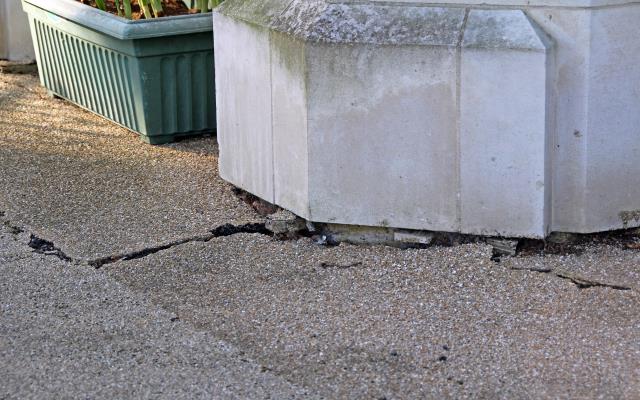Heave and subsidence are a real concern if they happen on your property, and you could be in for a moving experience. That's why it's important to recognise the signs and act quickly to limit the damage to your home's structure – and your insurance claims.

What is subsidence?
The Financial Ombudsman Service says subsidence happens when:
-
The ground beneath a building sinks, pulling the property’s foundations down with it.
It can happen when the ground contracts or shrinks due to a change in its water content. This can make the building's foundations crack or deform, which can then cause further structural damage. The clay-rich soils of south-east England are particularly susceptible to shrinkage and swelling, but the soils of river valleys (alluvium) are also vulnerable.
Preventing subsidence
There are a few steps you can take to protect your property from local causes of subsidence such as trees or drainage. These include:
- Keeping trees and shrubs a safe distance from your property. A tree surgeon (or arborist) can advise you on the best place to put the type of tree you want.
- Pruning trees regularly, though even severe crown reduction may only have a limited effect on soil drying.
- Checking and taking care of any leaking or blocked drains.
- Clearing dirt and leaf build up from gutters to avoid overflowing.
- Inspecting rainwater downpipes for cracks or splits.
Is subsidence the same as structural settlement?
No. While often confused with each other, they're indeed different. Settlement is common in new builds and structures that use materials such as timber.
In this case, the Financial Ombudsman Service says settlement is:
Downward movement as a result of soil being compressed by the weight of a building within 10 years of construction.
Building companies often reassess new builds every year to check for and fix structural settlements. Generally speaking, most home insurance policies don't provide cover for settlement, but check your insurance documents if you're unsure.
Remember, changes to your house (extensions, internal alterations) can restart settlement long after the original construction, and any new cracks may not be related to subsidence.
What is heave?
Also known as swelling, heave is the opposite to subsidence, and which the Financial Ombudsman Service describes as the:
Upward movement of the ground beneath a building as a result of the soil expanding.
One possible cause is when the ground on which the building sits absorbs too much water and expands. The extra water usually comes from flooding or the removal of nearby trees which hold large amounts of water during their lifespan. Like subsidence, heave causes a foundation to crack and deform.
The tips above for preventing subsidence are just as valid for heave, for you need to control any saturation of the soil. In either case, the hasty removal of nearby trees can have a worse effect than the problem you're trying to solve.
How to spot heave and subsidence
There are some tell-tale signs you can look for:
- Cracks in brickwork, and near doors and windows.
- Doors and windows sticking as their frames become out of place.
- Evidence of rising damp in the walls. If you've had damp-proof courses (DPC) installed in the past, you might need to bring in a professional to check them again. A DPC is a horizontal plastic, felt or slate layer put in your walls to prevent moisture from moving upwards (rising damp). Any cracks going through the DPC is usually a sign of subsidence.
- External cracking reflected internally in the same area of a cavity wall.
- Crumpling of wallpaper between the wall and ceiling.
- Cracks appearing after a long period of dry weather.
- When the seasons change, the opening and closing of existing cracks.
Cracking, therefore, is one of the more obvious signs of movement in your property, but this can also be due to natural decay or defects in the structure itself, thermal or moisture changes within the fabric, and modern repairs or alterations to older buildings.
Before you get too alarmed, the Building Research Establishment has provided some guidance on cracks in houses. Cracks up to 5mm wide may only require decoration, while one or more cracks over 15mm wide should be inspected by a surveyor or structural engineer.
Does my home insurance cover heave and subsidence?
Considering you usually have no control over it, heave or subsidence damage can put a strain on any homeowner. If you see cracks on your property, for peace of mind seek professional advice to assess the level of risk.
You can, though, check the age of your house and see how it was built. The remedy for a house built before 1914 will not be the same for one built in the 1990s, and the building surveyor must have experience and knowledge of the age or the type of your house.
And if your home was built before 1840 there's a good chance it could be a listed building. If so, any repairs that affect the structure will need to be approved by the local planning authority. And even if it's not listed or is in a conservation area, still contact the conservation officer at the same authority for their advice. Doing nothing to the building may be a good temporary option, as inappropriate works can't be undone.
If the verdict is for structural repairs, let your insurer know and find out what's covered by your buildings policy. Your home insurance may cover the cost of repairing loss or damage but not the excess, which can be costly.
Similarly, if you live in an area that's a flood risk, you should consider taking out contents insurance.
Author: The AA
Published 22 March 2018. Updated 16 June 2023.
